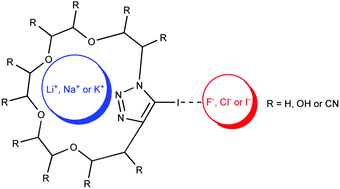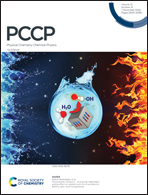The simultaneous recognition mechanism of cations and anions using macrocyclic–iodine structures: insights from dispersion-corrected DFT calculations†
Abstract
The recent development of compounds for recognizing ions highlights the applicability of this area. In this work, the simultaneous recognition of cations (Li+, Na+ and K+) and anions (F−, Cl− and I−) using a macrocycle comprising a simple crown ether and an iodine-triazole unit is investigated. The roles of the (i) cation radius, (ii) anion radius, and (iii) electron withdrawing (–CN) and donor (–OH) groups of the receptor in ionic recognition were evaluated. Energy decomposition analysis (EDA) shows that the ion–receptor interactions are attractive and predominantly electrostatic. Molecular electrostatic potential plots and EDA analysis reveal that a decreasing cation radius favors interactions with the oxygen atoms present in the crown ether. A decreasing anion radius increases the σ-hole interactions with the iodine atoms present in the receptors. In compounds containing –CN and –OH groups, the oxygen atoms in the crown ether show lower ability to interact with the Na+ cation. Nevertheless, in the receptor–OH structure, the Na+⋯OH interactions counterbalance the lower ability of the crown ether oxygens to interact with the Na+ cation. I− recognition is enhanced by the presence of –OH and, more strongly, –CN groups, occurring due to the increased σ-hole area in the receptor–CN structure, as supported by a C–H⋯I− interaction in the receptor–OH compound. The reported results are useful for the design of compounds with improved capabilities for both cation and anion recognition prior to engaging in exploratory synthesis efforts.



 Please wait while we load your content...
Please wait while we load your content...